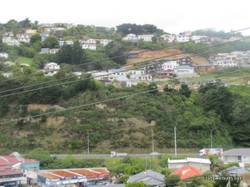The journey to the Place of Dread was uneventful, and finally he reached his destination, only to be disappointed that such an unprepossessing promontory was what he had travelled to visit. But Grimble had taken little water with him and in that droughty coral archipelago he ate his lunch and was unable to replenish his supplies of water. He began to be thirsty, and it was the growing thirst that led to what followed. They left after two in in the afternoon
Initially the colonial officer asked the Constable, who was walking forty paces behind, behind to scale a palm tree to get him a coconut, but the man refused to steal one of Nakaa's nuts, and there was still a mile of Nakaa's Grove to go. Then Grimble saw a figure. Maybe this man could scale a palm tree to assuage Grimble's thirst. The path curved round a beach and the figure was visible all the way. Grimble could not take his eyes from the man, for in him lay the remediation of his thirst. The time was approaching three o'clock.
As the man approached Grimble saw that he was a grizzled man in his fifties, walked with a limp,had a scar down his cheek and was clad in a fine mat around his waist. As the colonial officer bade him stop, the man simply walked past with no acknowledgement, as though Grimble were not there. This was strange behaviour for the usually courteous islanders, so Grimble thinking that there might be something wrong with the man ran back to the constable to get him to "ask that chief to stop." But the police officer stood uncomprehending, then fled in terror shielding his eyes.
On returning to the village the angry Grimble demanded that the man be brought to him that evening, but the magistrate asked for a description, which Grimble gave. Magistrate and constable agreed that it was Na Biria.
"Then bring him to me at once." the angry young man demanded.
"I cannot do that." replied the magistrate, who then told the dumbfounded officer that Na Biria had died that day shortly before three o'clock.
After Grimble demanded proof that the man was dead the magistrate took Grimble to Na Biria's house, but as he approached and saw the mourners he had a pang of conscience, for he knew that if the rituals were disturbed the Kiribatans would believe that Nakaa would strangle Na Biria in his net, and the officer did not want to cause good people such grief. He went away humbled and ashamed of his arrogance.









 Pilgrimage. A review19 days ago
Pilgrimage. A review19 days ago
 Leo the Fourteenthon 05/09/2025
Leo the Fourteenthon 05/09/2025
 The Melsonby Hoardon 03/25/2025
The Melsonby Hoardon 03/25/2025




Comments
It is impossible to say.
Thank you for your comment below in answer to my previous observation and question.
That those on "the other side" care for those on "this side" connects with those on "this side" caring about those on "the other side."
Bela Bartok considered that he expected to unpack his suitcases -- of things to do -- before his death even as life did not allow him to do so.
Does "the other side" giving us a death date, such as in the redcoat having time before Ticonderoga, aim in part for us to get done some if not all of what we'd like to get done?
Or would such practicalities perhaps not enter at all?
That is an unanswerable question.
Thank you for your comment below in answer to my previous observation and question.
That's a rather chilling, unsettling story about the redcoat hearing about where his death was "scheduled" through a dead relative.
The military service might have kept him from doing everything he could to avoid Ticonderoga!
(But what would have happened had he succeeded? Would it even be possible to avoid a death date once advised by someone on "the other side"?)
There are many ghost stories which tell of people having a premonitory vision? There is one inn which a red coat going to America saw a dead relative who told him that they would meet at Ticonderoga. They did
Thank you for your comment below in answer to my previous observation and question.
The belief of seeing a ghost forecasting death within one year is unsettling. Might belief and actuality have any known correlations?
The inhabitants rarely visit the Place of Dread because they believe that if you see a ghost you will die within a year, so walking back along the paths to the place makes you likely to come face to face with a ghost.
Rituals for the dead take place in the deceased person's home. The rituals do not take place at the Place of Dread.
frankbeswick, Thank you for the practical information and the product lines.
You indicate that "The inhabitants of the isle rarely visit the Place of Dread." Is Pattern of the Islands informative about the reasons that prompt rare local visits there? Is saying the proper rituals over the dead a reason or would they be sayable at the actual place of death or even somewhere else?
I'm impressed that Sir Arthur Grimble backed down and did not try to interfere with native beliefs, plus that he acknowledged he could have actually seen the dead man's spirit.
Quite right. What intrigued me was that Grimble saw the man from a distance. It was not therefore a transitory apparition.